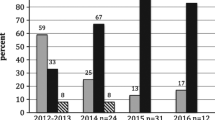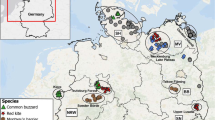Abstract
Anticoagulant rodenticides (ARs) are used globally to control rodent pest infestations in both urban and agricultural settings. It is well documented that non-target wildlife, including predatory birds, are at risk for secondary anticoagulant exposure and toxicosis through the prey they consume. However, there have been no large-scale studies of AR exposure in raptors in Ontario, Canada since new Health Canada legislation was implemented in 2013 in an attempt to limit exposure in non-target wildlife. Our objective was to measure levels of ARs in wild raptors in southern Ontario to assess their exposure. We collected liver samples from 133 raptors representing 17 species submitted to the Canadian Wildlife Health Cooperative (CWHC) in Ontario, Canada, between 2017 and 2019. Liquid chromatography-tandem mass spectrometry (LC–MS/MS) was used to quantitatively assess the level of exposure to 14 first- and second-generation ARs. Detectable levels of one or more ARs were found in 82 of 133 (62%) tested raptors, representing 12 species. The most commonly detected ARs were bromadiolone (54/133), difethialone (40/133), and brodifacoum (33/133). Of AR-positive birds, 34/82 (42%) contained residues of multiple (> 1) anticoagulant compounds. Our results indicate that AR exposure is common in raptors living in southern Ontario, Canada. Our finding that brodifacoum, difethialone, and bromadiolone were observed alone or in combination with one another in the majority of our sampled raptors indicates that legislative changes in Canada may not be protecting non-target wildlife as intended.

Similar content being viewed by others
Data availability
The datasets used and analyzed during the current study are available from the corresponding author on reasonable request.
References
Albert CA, Wilson LK, Mineau P, Trudeau S, Elliott JE (2010) Anticoagulant rodenticides in three owl species from Western Canada, 1988–2003. Arch Environ Contam Toxicol 58:451–459. https://doi.org/10.1007/s00244-009-9402-z
Coeurdassier M, Villers A, Augiron S, Sage M, Couzi F, Lattard V, Fourell I (2019) Pesticides threaten an endemic raptor in an overseas French territory. Biol Conserv 234:37–44. https://doi.org/10.1016/j.biocon.2019.03.022
Elliott JE, Hindmarch S, Albert CA, Emery J, Mineau P, Maisonneuve F (2014) Exposure pathways of anticoagulant rodenticides to nontarget wildlife. Environ Monit Assess 186:895–906. https://doi.org/10.1007/s10661-013-3422-x
Elliott JE, Rattner BA, Shore RF, Van Den Brink NW (2016) Paying the pipers: mitigating the impact of anticoagulant rodenticides on predators and scavengers. Bioscience 66:401–407. https://doi.org/10.1093/biosci/biw028
Erickson W, Urban D (2004) Potential risks of nine rodenticides to birds and nontarget mammals: a comparative approach. United States Environmental Protection Agency, Office of Prevention, Pesticides and Toxic Substances, Washington
Gabriel MW, Woods LW, Poppenga R, Sweitzer RA, Thompson C, Matthews SM, Higley JM, Keller SM, Purcell K, Barrett RH, Wengert GM, Sacks BN, Clifford DL (2012) Anticoagulant rodenticides on our public and community lands: spatial distribution of exposure and poisoning of a rare forest carnivore. PLoS ONE 7:e40163. https://doi.org/10.1371/journal.pone.0040163
Geduhn A, Esther A, Schenke D, Gabriel D, Jacob J (2016) Prey composition modulates exposure risk to anticoagulant rodenticides in a sentinel predator, the barn owl. Sci Total Environ 544:150–157. https://doi.org/10.1016/j.scitotenv.2015.11.117
Hindmarch S, Elliot JE, Morzillo A (2018) Rats! What triggers us to control for rodents? Rodenticide user survey in British Columbia, Canada. Int J Environ Sci 75:1011–1030. https://doi.org/10.1080/00207233.2018.1479565
Hindmarch S, Rattner BA, Elliot JE (2019) Use of blood-clotting assays to assess potential anticoagulant rodenticide exposure and effects in free-ranging birds of prey. Sci Total Environ 657:1205–1216. https://doi.org/10.1016/j.scitotenv.2018.11.485
Hindmarch S, Elliot JE (2018) Ecological factors driving uptake of anticoagulant rodenticides in predators. In: van den Brink N, Elliott JE, Shore EF, Rattner BA(eds) Anticoagulant Rodenticides and Wildlife, Springer Nature, Cham, Switzerland, pp 228–258
Huang AC, Elliot JE, Hindmarch S, Lee SL, Maisonneuve F, Bowes V, Cheng KM, Martin K (2016) Increased rodenticide exposure rate and risk of toxicosis in barn owls (Tyto alba) from southwestern Canada and linkage with demographic but not genetic factors. Ecotoxicology 25:1061–1071. https://doi.org/10.1007/s10646-016-1662-6
Hughes J, Sharp E, Taylor MJ, Melton L, Hartley G (2013) Monitoring agricultural rodenticide use and secondary exposure of raptors in Scotland. Ecotoxicology 22:974–984. https://doi.org/10.1007/s10646-013-1074-9
Lohr MT (2018) Anticoagulant rodenticide exposure in an Australian predatory bird increases with proximity to developed habitat. Sci Total Environ 643:134–144. https://doi.org/10.1016/j.scitotenv.2018.06.207
López-Perea JJ and Mateo R (2018) Secondary exposure of anticoagulant rodenticides and effects in predators. In: van den Brink NW, Elliott JE, Shore RF, Rattner BA(eds) Anticoagulant rodenticides and wildlife, Springer Nature, Cham, Switzerland, pp. 159–193
Marti CD, Kochert MN (1995) Are red-tailed hawks and great-horned owls diurnal-nocturnal dietary counterparts? Wilson Bull 107:615–628
Murray M (2018) Ante-mortem and post-mortem signs of anticoagulant rodenticide toxicosis in birds of prey. In: van den Brink NW, Elliott JE, Shore RF, Rattner BA(eds) Anticoagulant rodenticides and wildlife, Springer Nature, Cham, Switzerland, pp 109–134
Naim M, Noor HM, Kasim A, Abu J (2011) Comparison of the breeding performance of the owl Tyto alba javanica under chemical and bio-based rodenticide baiting in immature oil palms in Malaysia. Dyn Biochem Process Biotechnol Mol Biol 5:5–11
Nakayama S, Morita A, Ikenaka Y, Mizukawa H, Ishizuka M (2019) A review: poisoning by anticoagulant rodenticides in non-target animals globally. J Vet Med Sci 81:298–313. https://doi.org/10.1292/jvms.17-0717
NatureServe (2020) NatureServe Explorer https://explorer.natureserve.org/. Accessed: 28 Aug 2020
Newton I, Dale L, Finnie JK, Freestone P, Wright J, Wyatt C, Wyllie I (1998) Wildlife and pollution: 1997/98 annual report, JNCC Report No. 285. Joint Nature Conservation Committee, Peterborough, UK.
Newton I, Wyllie I, Freestone P (1990) Rodenticides in British barn owls. Environ Pollut 68:101–117. https://doi.org/10.1016/0269-7491(90)90015-5
Newton I, Shore RF, Wyllie I, Birks JDS, Dale L (1999) Empirical evidence of side-effects of rodenticides on some predatory birds and mammals. In: Cowan DP, Feare CJ (eds) Advances in vertebrate pest management. Filander Verlag, Furth, pp 347–367
Niedringhaus KD, Nemeth NM, Gibbs S, Zimmerman J, Shender L, Slankard K, Fenton H, Charlie B, Dalton MF, Elsmo EJ, Poppenga R, Millsap B, Ruder MG (2021) Anticoagulant rodenticide exposure and toxicosis in bald eagles (Haliaeetus leucocephalus) and golden eagles (Aquila chrysaetos) in the United States. PLoS ONE 16(4):e0246134. https://doi.org/10.1371/journal.pone.0246134
Ontario Ministry of Natural Resources (2007) Ontario regulation 230/08: species at risk in Ontario list under endangered species act, 2007, s.o. 2007, c. 6. https://www.ontario.ca/laws/statute/07e06. Accessed 01 August 2019
Pelfrene AF (1991) Synthetic organic rodenticides. In: Hayes WJ, Laws ER (eds) Handbook of pesticide toxicology, Vol. 3: Classes of Pesticides, Academic Press, Inc. 1271–1316
PMRA (2010) Proposed risk mitigation measures for eight rodenticides, REV2010–17. Pest Management Regulatory Agency, Health Canada, Ottawa, Ontario.
PMRA (2012a) New use restrictions for commercial class rodenticides in agricultural settings. Pest Management Regulatory Agency, Health Canada, Ottawa, Ontario. https://www.canada.ca/en/health-canada/services/consumer-product-safety/reports-publications/pesticides-pest-management/fact-sheets-other-resources/rodenticides-agricultural-settings.html. Accessed 09 Jul 2020
PMRA (2012b) Questions and answers – additional mitigation measures for rodenticides. Pest Management Regulatory Agency, Health Canada, Ottawa, Ontario. https://www.canada.ca/content/dam/hc-sc/migration/hc-sc/cps-spc/alt_formats/pdf/pubs/pest/_fact-fiche/restriction-rodenticides/faq-eng.pdf. Accessed 09 Jul 2020
Quinn N (2019) Assessing individual and population-level effects of anticoagulant rodenticides on wildlife. Hum-Wildl Interact 13:200–211. https://doi.org/10.1371/journal.pone.0040163
Rattner BA, Barnett A, Mastrota FN (2018) Anticoagulant rodenticide toxicity to non-target wildlife under controlled exposure conditions. In: van den Brink NW, Elliott JE, Shore RF, Rattner BA (eds) Anticoagulant rodenticides and wildlife, Springer Nature, Cham, Switzerland, pp 45–86
Rattner BA, Harvey JJ (2021) Challenges in the interpretation of anticoagulant rodenticide residues and toxicity in predatory and scavenging birds. Pest Manag Sci 77:604–610. https://doi.org/10.1002/ps.6137
Rattner BA, Horak KE, Warner SE, Day DD, Meteyer CU, Volker SF, Eisemann JD, Johnston JJ (2011) Acute toxicity, histopathology, and coagulopathy in American kestrels (Falco sparverius) following administration of the rodenticide diphacinone. Environ Toxicol Chem 30:1213–1222. https://doi.org/10.1002/etc.490
Rattner BA, Horak KE, Lazarus RS, Goldade DA, Johnston JJ (2014a) Toxicokinetics and coagulopathy threshold of the rodenticide diphacinone in eastern screech-owls (Megascops asio). Environ Toxicol Chem 33:74–81. https://doi.org/10.1002/etc.2390
Rattner BA, Lazarus RS, Elliott JE, Shore RF, van den Brink N (2014b) Adverse outcome pathway and risks of anticoagulant rodenticides to predatory wildlife. Environ Sci Technol 48:8433–8445. https://doi.org/10.1021/es501740n
Regnery J, Schulz RS, Parrhysius RS, Bachtin J, Brinke M, Schäfer S, Reifferscheid G, Friesen A (2020) Heavy rainfall provokes anticoagulant rodenticides’ release from baited sewer systems and outdoor surfaces into receiving streams. Sci Total Environ 740:139905. https://doi.org/10.1016/j.scitotenv.2020.139905
Scott DE (2016) Species overview. In: Scott D (ed) Raptor medicine, surgery, and rehabilitation, 2nd edn. CABI, Boston, pp 21–80
Smith L, Liang B, Booth M, Filigenzi M, Tkachenko A, Gaskill C (2017) Development and validation of quantitative ultraperformance liquid chromatography-tandem mass spectrometry assay for anticoagulants rodenticides in liver. J Agric Food Chem. https://doi.org/10.1021/acs.jafc7b02280
Smith KA, Campbell GD, Pearl DL, Jardine CM, Salgado-Bierman F, Nemeth NM (2018) A retrospective summary of raptor mortality in Ontario, Canada (1991–2014), including the effects of West Nile Virus. J Wild Dis 54:261–271. https://doi.org/10.7589/2017-07-157
Stansley E, Cummings M, Vudathala D, Murphy LA (2014) Anticoagulant rodenticides in red-tailed hawks, Buteo jamaicensis, and great horned owls, Bubo virginianus, from New Jersey, USA, 2008–2010. Bull Environ Contam Toxicol 92:6–9. https://doi.org/10.1007/s00128-013-1135-z
Statistics Canada (2011) From urban areas to population centres - Archived information. http://www.statcan.gc.ca/eng/subjects/standard/sgc/notice/sgc-06. Accessed: 30 June 2017
Stone WB, Okoniewski JC, Stedelin JR (2003) Anticoagulant rodenticides and raptors: recent findings from New York, 1998–2001. Bull Environ Contam Toxicol 70:34–40. https://doi.org/10.1007/s00128-002-0152-0
Thijssen HHW (1995) Warfarin-based rodenticides: mode of action and mechanism of resistance. Pestic Sci 43:73–78. https://doi.org/10.1002/ps.2780430112
Thomas PJ, Mineau P, Shore RF, Champoux L, Martin PA, Wilson LK, Fitzgerald G, Elliott JE (2011) Second generation anticoagulant rodenticides in predatory birds: probabilistic characterisation of toxic liver concentrations and implications for predatory bird populations in Canada. Environ Int 37:914–920. https://doi.org/10.1016/j.envint.2011.03.010
Vandenbroucke V, Bousquet-Melou A, De Backer P, Croubels S (2008) Pharmacokinetics of eight anticoagulant rodenticides in mice after single oral administration. J Vet Pharmacol Ther 31:437–445. https://doi.org/10.1111/j.1365-2885.2008.00979.x
Vyas NB (2017) Rodenticide incidents of exposure and adverse effects on non-raptor birds. Sci Total Environ 609:68–76. https://doi.org/10.1016/j.scitotenv.2017.07.00
Acknowledgements
We are grateful to the wildlife rehabilitation organizations, wildlife biologists, and members of the public who submitted carcasses to the Canadian Wildlife Health Cooperative (CWHC), especially Fatal Light Awareness Program (FLAP) Canada, the Owl Foundation, Shades of Hope Wildlife Refuge, and the Toronto Wildlife Centre. CWHC colleagues, including Laura Dougherty and Dan Hughes, the staff of the Avian and Exotics service of the Ontario Veterinary College, and Rachel Finer provided technical support. We thank Dr. Doug Campbell for his support in develo** this project.
Funding
Project funding was through the Ontario Animal Health Network, which is supported by the University of Guelph-OMAFRA Partnership Agreement.
Author information
Authors and Affiliations
Contributions
All authors contributed to the study conception and design. Data collection was performed by Grace L. Thornton and Brian Stevens. Laboratory and data analysis were performed by Grace L. Thornton, Shannon K. French, Leonard J. Shirose, Felipe Reggeti, and Nick Schrier. The first draft of the manuscript was written by Grace L. Thornton, and all authors commented on previous versions of the manuscript. All authors read and approved the final manuscript.
Corresponding authors
Ethics declarations
Ethics approval and consent to participate
All sampling was conducted on opportunistically collected and donated deceased animals, so no ethics approval is required. No animals were harmed for the purposes of this study.
Consent for publication
Not applicable.
Competing interests
The authors declare no competing interests.
Additional information
Responsible Editor: Philippe Garrigues
Publisher's note
Springer Nature remains neutral with regard to jurisdictional claims in published maps and institutional affiliations.
Supplementary Information
Below is the link to the electronic supplementary material.
Rights and permissions
About this article
Cite this article
Thornton, G.L., Stevens, B., French, S.K. et al. Anticoagulant rodenticide exposure in raptors from Ontario, Canada. Environ Sci Pollut Res 29, 34137–34146 (2022). https://doi.org/10.1007/s11356-022-18529-z
Received:
Accepted:
Published:
Issue Date:
DOI: https://doi.org/10.1007/s11356-022-18529-z




